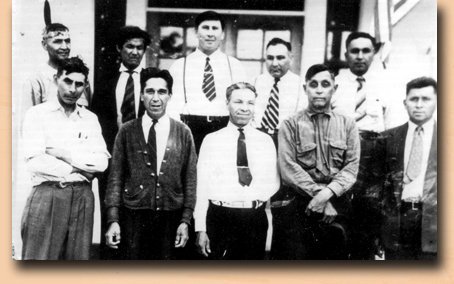6650 E. Broadway • Mt. Pleasant, MI 48858
Phone: 989-775-4750 • Fax: 989-775-4770
Hours Of Operation

10,000+ Years ago
Anishinabek lived along the Atlantic seaboard from what is now Nova Scotia to the Carolinas
900 AD
Anishinabek began the Great Walk to the Great Lakes area and beyond
1200-1300s
The Anishinabek established the Three Fires Confederacy throughout the Great Lakes.
The Three Fires Confederacy includes the Ojibway (Chippewa), Odawa (Ottawa), and Odawatomi (Potawatomi)
1640s
First European visitors (French) make contact with Anishinabek in Baawaating (Sault Ste. Marie)
1785-1864
The U.S. Government began making
treaties with the Saginaw Chippewa
Indian Tribe.
Sixteen treaties were made between
1795-1864. The Saginaw Chippewa
signed treaties with the United States
ceding almost all of their land.
1855 and 1864
The Saginaw Chippewa sign two treaties with the United States, which established the Isabella Indian Reservation.
1924
Indian Citizenship Act established
1937
Saginaw Chippewa Indian Tribe is reorganized under the Indian Reorganization Act
1996
Soaring Eagle Casino opens
1998
Soaring Eagle Resort opens
2000
Saginaw Chippewa Indian Tribe becomes largest employer in Isabella County
2004
Ziibiwing Center of Anishinabe Culture & Lifeways opens
2007
Andahwod Continuing Care Community & Elder Services opened
2008
Saganing Eagles Landing Casino opened
2010
Federal Court upheld Isabella Reservation historical boundaries
2012
Soaring Eagle Waterpark & Hotel and Hideaway RV Park opened

The Saginaw Chippewa Indian Tribe of Michigan is comprised of three bands of Ojibway (Saginaw, Black River, Swan Creek), who lived primarily in the Eastern region of what is now Michigan. Our ancestors lived in this area for hundreds of years prior to the appearance of European settlers. Two hundred years after their arrival, they claimed all but a few acres of the land where our ancestors had made their homes. The last treaties we signed with the United States in 1855 and 1864, established the Isabella Indian Reservation. Totaling over 130,000 acres, this land was divided into privately-owned allotments establishing a permanent home for our tribal membership.
When our people moved to the Isabella Indian Reservation the conditions were extremely grim and our annuity payments were delayed, causing many of our people to succumb to hunger and sickness. During this time, Isabella County had some of the best stands of white pine in the whole state of Michigan and lumbermen were eager to swindle us out of our lands. Many of our people sold their allotments to lumber sharks for a small fraction of their value. For many, selling their allotment was the only way to feed their families. This, coupled with numerous shoddy deals between Indian Agents and timber barons, led to a rapid dispossession of our land base. Of the more than 1,500 allotments issued to our ancestors in the late 1800s, only a handful of these were owned by tribal members by 1934.
In 1934 the Indian Reorganization Act (IRA) was passed, which sought to improve conditions for tribes in the United States. The IRA required tribes to adopt a constitution and elect a tribal council in order to be a federally-recognized tribe. We elected our first tribal council and adopted our constitution in 1937. At this time, our tribe acquired 500 acres east of Mt. Pleasant to establish a land base for our people.
Through the resiliency of our ancestors we have endured and overcome many obstacles that were placed before us.
The recent success of our gaming and entertainment operation has enabled us to better provide for the needs of our community. Housing, health care, and educational opportunities have greatly improved in the past 20 years for the tribal membership.
The tribe also provides opportunities for our non-Native neighbors as the largest employer in Isabella County.
Our economic success has also given us the means to reclaim the history of our people and share it with the rest of the world. The 34,349 sq. ft. Ziibiwing Center of Anishinabe Culture & Lifeways was established in May of 2004 with that goal in mind. Our cultural center and tribal museum honors the ancestors, who against tremendous odds, protected and passed down the cultural knowledge, language, and teachings of our people.




